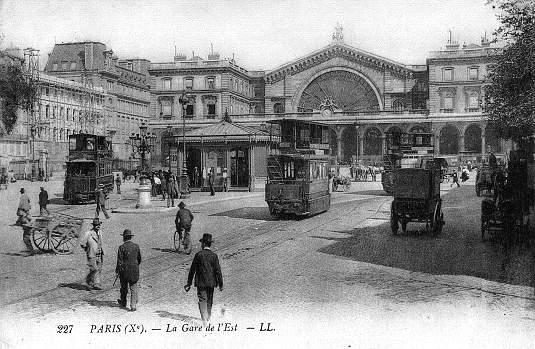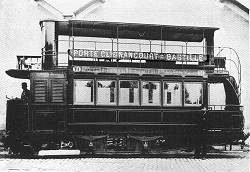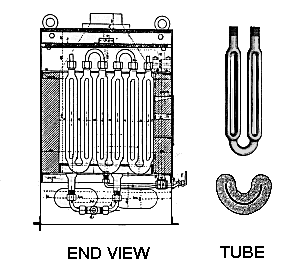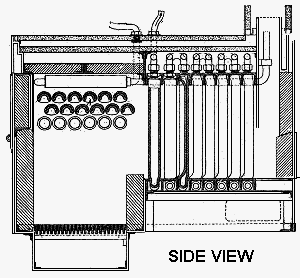

This fine postcard was published by Lévy Fils et Cie, of 44 Rue Letellier, Paris, and shows the Gare de l'Est in that city. It dates from around 1910, our example being posted on 28th August 1911. The trams in the centre and on the right are Mékarski cars and are fully described in our article on Compressed Air Trams. The tram on the left, which we will consider here, is a Serpollet steam tram. It is car 437 of the Compagnie Générale des Omnibus (CGO) and is on Route TI travelling from Cimetière Saint-Ouen to Bastille.
Léon Serpollet was born in Culoz, France in 1858 and around 1881 first designed his boiler system, going on to form the Société des Générateurs a Vaporisation Instantanée of 15 Rues des Halles, Paris to manufacture the "Système Serpollet". This was covered by many patents world-wide, but is best described in respect of these trams in French patents 221,679 dated 17th May 1892 and 251,540 dated 8th November 1895. The system used what in English is known as a flash boiler, which is a compact unit providing steam power on demand, is quick to be brought up to working temperature and is ideal for road vehicles. It uses very thick boiler tubes with a capillary micro-bore. These are heated to a high temperature and then when steam is required, cold water is injected into the tubes causing it to "flash" into steam.
The first prototype Serpollet car in Paris was tested by the Tramways de Paris et du Département de la Seine (TPDS) in 1893, followed by 23 trams (numbered 1-23) of 50 passenger capacity being operated between 1895 and 1901 on their routes from Madeleine to Grennevilliers, Asnière and Colombes. The CGO first tested a car in 1895 and then used them on route TI from 23rd June 1897. Over the next few years their use was extended at various times to routes TQ, TE, TC and TH, despite a few spectacular boiler explosions in later days.
 Car 437 in our postcard was one of a batch of 60 cars numbered 401 to 460, the type shown in this official side view (left). The were 9.13 metres long, 2.10 metres wide and 4.62 metres high. They carried 52 passengers, 20 inside, 26 on top and 6 on the rear platform. They were single ended, passengers boarding at the rear where there was a staircase to the top deck. The steam generator was at the front, separating the saloon and the drivers position. The cylinders were below the front platform. With all the weight at one end of the car, additional weight had to be added to the rear, bringing the total to 13.3 tons (16.8 tons fully loaded). Similar Purrey cars were less than 10 tons, a reason why after 1907 some Serpollet boiler units were replaced with Purrey ones. The simple controls on the front platform were a reversing handle and cut-off, a speed regulator, the brake handle and a starting pump. The cars were lit by paraffin lamps excepts for those on route TQ which used acetylene and a few on TI which had electric batteries. Exhaust steam could be used to heat the saloon with condensed steam being returned to the 350 litre water tank or could be passed via a firebox reheater, so that it would be invisible as it left the chimney. The truck was 1.90 metre wheelbase and had 820 mm diameter wheels.
Car 437 in our postcard was one of a batch of 60 cars numbered 401 to 460, the type shown in this official side view (left). The were 9.13 metres long, 2.10 metres wide and 4.62 metres high. They carried 52 passengers, 20 inside, 26 on top and 6 on the rear platform. They were single ended, passengers boarding at the rear where there was a staircase to the top deck. The steam generator was at the front, separating the saloon and the drivers position. The cylinders were below the front platform. With all the weight at one end of the car, additional weight had to be added to the rear, bringing the total to 13.3 tons (16.8 tons fully loaded). Similar Purrey cars were less than 10 tons, a reason why after 1907 some Serpollet boiler units were replaced with Purrey ones. The simple controls on the front platform were a reversing handle and cut-off, a speed regulator, the brake handle and a starting pump. The cars were lit by paraffin lamps excepts for those on route TQ which used acetylene and a few on TI which had electric batteries. Exhaust steam could be used to heat the saloon with condensed steam being returned to the 350 litre water tank or could be passed via a firebox reheater, so that it would be invisible as it left the chimney. The truck was 1.90 metre wheelbase and had 820 mm diameter wheels.
 The Serpollet boiler was multi-tubed using "U" shaped tubes connected outside the firebox, each tube being crescent shaped in cross section, as can be seen in the diagram (right). The bore was 2mm to 5mm depending on how far it was located from the point of water entry. The tube walls were around 12 mm thick. Water was injected into the tubes by means of two pumps, a hand one to start the car moving and one driven from the front axle to continue the action once the car was in motion. If the water pressure exceeded that required to produce the necessary steam for a given speed, a valve lifted to divert the water back to the supply tank.
The Serpollet boiler was multi-tubed using "U" shaped tubes connected outside the firebox, each tube being crescent shaped in cross section, as can be seen in the diagram (right). The bore was 2mm to 5mm depending on how far it was located from the point of water entry. The tube walls were around 12 mm thick. Water was injected into the tubes by means of two pumps, a hand one to start the car moving and one driven from the front axle to continue the action once the car was in motion. If the water pressure exceeded that required to produce the necessary steam for a given speed, a valve lifted to divert the water back to the supply tank.
 There were two sets of boiler tubes, a horizontal one above the firebox grate with three rows each of nine tubes and a vertical one of 8 staggered rows of 23 tubes spaced about 100 mm apart, as can be seen in the diagram (left). Each tube was 0.55 metres long. There was a total heating surface of 8.35 square metres and a grate area of 0.40 square metres. The steam was heated to 300-350 degrees C. and the tubes were tested at a pressure of 94 kg/square cm. The boiler unit was 1.774 metres wide by 0.894 metres deep and weighed 2.47 tons. In use at average speed of 12-15 kph, the car would consume about 70 kg of coke per hour, with 1 kg of coke vaporising 4-5 litres of water.
There were two sets of boiler tubes, a horizontal one above the firebox grate with three rows each of nine tubes and a vertical one of 8 staggered rows of 23 tubes spaced about 100 mm apart, as can be seen in the diagram (left). Each tube was 0.55 metres long. There was a total heating surface of 8.35 square metres and a grate area of 0.40 square metres. The steam was heated to 300-350 degrees C. and the tubes were tested at a pressure of 94 kg/square cm. The boiler unit was 1.774 metres wide by 0.894 metres deep and weighed 2.47 tons. In use at average speed of 12-15 kph, the car would consume about 70 kg of coke per hour, with 1 kg of coke vaporising 4-5 litres of water.
The motor was mounted below the platform floor in a hermetically sealed sheet iron box, which when running would be filled by a hot oily vapour to keep the mechanism lubricated. There were two cylinders with 0.16 metre bore and 0.5 metre stroke connected to a 90 degree crankshaft. This shaft was joined to the front axle by two chains drives, one each side of the car, with a 2.5:1 reduction. The front axle was in turn linked to the rear by a third chain. With the crankshaft turning at 195 r.p.m. the car would travel at 12 kph (the maximum speed was about 16kph). The car was fitted with Soulerin air brakes fed from an axle driven compressor.
In 1900 the CGO built a prototype oil-fired car (numbered 801) using the Serpollet system and exhibited it at the Paris Exposition of that year, together with Purrey steam car 722, Mékarski compressed air car 128 and Fives-Lille accumulator car 586. Some ten other tramways and light railways (eight in France) also tried a small number of Serpollet trams. The largest user of the Système Serpollet trams other than Paris was Tours (1895-1900), with ten cars from three different builders, similar to the Paris ones but single-deck. The Serpollet boiler system was used on Darracq buses which ran for a while in Paris and London, and was tested on main line railway railcars. Meanwhile Serpollet designed a three-wheeled steam car in 1887 and in 1889 Peugeot, previously a manufacturer of bicycles, produced their first automobile, a Serpollet boiler powered three-wheeler. Ultimately on 13th April 1902 Serpollet himself, in a steam car of his own design, captured the World land speed record over a flying kilometre on the Promenade des Anglais in Nice at a speed of 75.1 mph (120.8 kph).
Léon Serpollet died in 1907. The last Serpollet steam tram to run in Paris was on route TQ from Porte d'Ivry to Les Halles on 12th November 1913.
![]() Go to Postcard Of The Month Index
Go to Postcard Of The Month Index